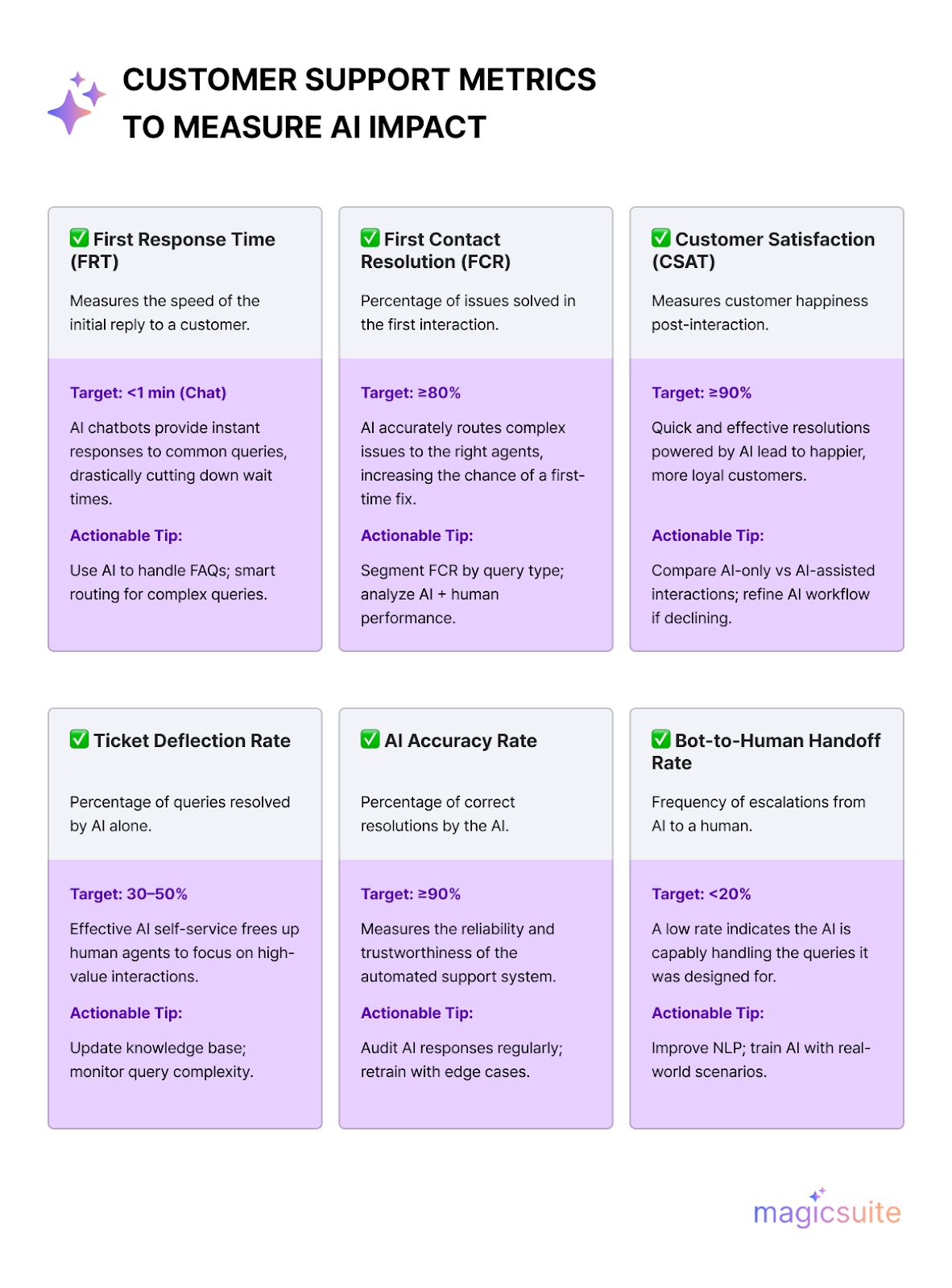Learn the customer service KPIs and customer support metrics that measure AI impact. Explore actionable customer service KPI examples to optimize efficiency, satisfaction, and ROI.

Customer support KPIs are quantifiable indicators that measure the efficiency, quality, and impact of your customer service operations. With AI tools like chatbots, virtual assistants, and automated ticket routing becoming mainstream, traditional metrics alone are no longer sufficient.
AI-Specific Benefits to Track:
To truly understand the ROI of AI in customer service, you need to track KPIs that reflect both human and AI performance.

Below are the most relevant customer support metrics that will help you evaluate how well your AI systems are performing.
First Response Time is the average time it takes for a customer to receive the first response after submitting a query. AI tools like chatbots can drastically reduce FRT, offering instant replies and improving customer satisfaction.
How to Optimize:
Pro Tip: Track FRT by query type (simple vs complex). Measure AI + human handoffs separately.
FCR measures the percentage of customer issues resolved during the first interaction. AI can significantly boost FCR by:
Compare FCR rates before and after AI implementation. A noticeable increase indicates AI's success in resolving issues faster and more efficiently.
CSAT measures customer happiness with your service, typically through surveys after an interaction. While AI aims for efficiency, it should never come at the expense of customer satisfaction.
How to track AI impact: Monitor CSAT scores closely. Track CSAT for AI-only vs AI-assisted interactions. If AI is implemented effectively, you should see either stable or improved CSAT scores. A declining CSAT suggests AI isn't meeting customer expectations.
The Net Promoter Score measures customer loyalty and the likelihood of recommending your brand.
AI Influence:
Ticket Deflection Rate is the percentage of customer issues resolved without human intervention. Chatbots and self-service portals play a key role in this as machine learning helps improve deflection over time
Optimization Tips:
Also check out What is MTTR: A Metric SMEs Can’t Ignore
Let’s explore some more nuanced customer service KPI examples that are particularly relevant in AI-enhanced environments.
A high handoff rate may indicate that your AI is not effectively resolving issues. To improve it, enhance NLP (Natural Language Processing) capabilities and train your bots with real-world scenarios
The AI Accuracy Rate Measures how often AI provides the correct answer or solution. Watch for misunderstood queries and incorrect suggestions
Best Practices:
This measures the number of customer interactions managed entirely by AI. It demonstrates scalability and cost-effectiveness of your tool. To track it, use a smart analytics dashboard and segment data by channel (chat, email, voice).
This customer service KPI measures the average cost incurred for each customer interaction. AI can significantly reduce this cost by reducing the need for human agents for simple tasks and making human agents more efficient.
How to track AI impact: A decrease in cost per contact post-AI implementation demonstrates a tangible return on investment.
AHT is the average time an agent spends on a customer interaction, from start to finish. AI can reduce AHT by:
How to track AI impact: A decrease in AHT directly reflects AI's ability to streamline interactions and make agents more productive.

The most critical KPIs include:
AI improves response times, increases resolution efficiency, and enhances customer satisfaction. It also introduces new metrics like bot accuracy and handoff rates.
No. While AI can handle routine queries, human agents are essential for complex, emotional, or high-stakes issues. The best approach is a hybrid model.
Track changes in key KPIs before and after AI implementation. Look for improvements in resolution time, CSAT, and cost per ticket.
Measuring AI's impact isn't about tracking just one customer service KPI. It's about taking a holistic approach, analyzing how these customer support metrics collectively paint a picture of enhanced efficiency, improved customer satisfaction, and optimized operational costs.
Regularly review these KPIs, adapt your AI strategies based on the insights gained, and continuously strive for a seamless and highly effective customer support experience.
So, start measuring what truly matters—and let your KPIs tell the story of your AI success.

Hanna is an industry trend analyst dedicated to tracking the latest advancements and shifts in the market. With a strong background in research and forecasting, she identifies key patterns and emerging opportunities that drive business growth. Hanna’s work helps organizations stay ahead of the curve by providing data-driven insights into evolving industry landscapes.